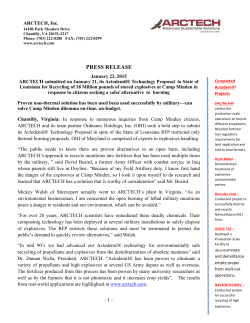
Data Tables
Show Me The Data! • Whenever you answer a question in science, you must have evidence to support your ideas. Data Tables Unit Essential Question: How does science use inquiry to further understanding? Presentation Objectives: ★ Present basic rules and guidelines for data tables. ★ Identify the information needed in a MEASURED Data Table. ★ Create an appropriate measured and calculated data table for given experiments. • Conduct an experiment to collect data, which are the measurements and observations made during the investigation. • To help communicate your findings, it is important to present the data in an organized fashion. • Multiple ways to access the information! • Table(s) • Graph(s) Guidelines For A Measured Data Table Data Tables • A good data table must be neat and organized.! • Drawn nicely with a ruler or on the computer.! • Title the table with a descriptive/informative name.! • The title should tell your reader what it is about.! • The title is typically similar to your lab question! • Label all columns and rows with appropriate quantity titles.! • Include units for each quantity. e Title Units Labels • Your data table will include THREE sections. • The independent variable is in the first section. • The dependent variable is in the last section. • There will be multiple constants in the middle. To figure out what you need in the Measure Data Table, you must first identify the IV, DV, and the constants! Lab Question: How does the amount of fertilizer given to a plant affect how tall it grows? IV = Amount of fertilizer Constants = Plant Type Amount of water DV = Height of the Plant Type of fertilizer Amount of sunlight Guidelines For Making A Data Table Let’s Give It A Try! Table 1: The Effect of Fertilizer Amount on the Height of Pea Plants Table 1: The Effect of Fertilizer Amount on the Height of Pea Plants Constants Independent Variable Dependent Variable T1 T2 T3 errors. ! Amt of Water (mL) Amt of Sun (hrs) 0 Pea Gro Fast! 25 5 Pea Gro Fast! 10 Pea 15 Pea Height of Plant (cm) T1 T2 T3 T4 3 5 6 5 7 25 3 10 10 11 10 Gro Fast! 25 3 15 12 14 13 Gro Fast! 25 3 17 18 17 19 • Fill in the IV values you will test in order from smallest to largest.! When we use the same IV values multiple times, the DV values may be different.! • Type of Fertilizer T4 • In science, we run the experiment multiple times to help find • Type of Plant Amt of Fertilizer (g) • Conduct experiment and record DV values! Subdivide the dependent variable column. Guidelines For A Calculated Data Table Calculated Data Table • It is often more useful to calculate another value from the data you measured during your experiment.! • Use this value to answer the lab question. Type of Plant Type of Fertilizer Amt of Water (mL) Amt of Sun (hrs) 0 Pea Gro Fast! 25 5 Pea Gro Fast! 10 Pea 15 Pea Amt of Fertilizer (g) Fill in the constants before you start the experiment. • Your calculated data table will include TWO sections; the first is for the independent variable and second is for the calculated value(s).! • The most common calculated value is the average of the trials. Like your measured data table, your calculated table should be: Height of Plant (cm) • • • Neat and organized! Include labels and correct units! T1 T2 T3 T4 3 5 6 5 7 25 3 10 10 11 10 Gro Fast! 25 3 15 12 14 13 0 Gro Fast! 25 3 17 18 17 19 5 The purpose of the calculated data table is to communicate the quantities that you have calculated using your data. Have a proper title that is descriptive/informative. Table 2: The Effect of Fertilizer Amount on the Average Height of Pea Plants Amount of Fertilizer (g) 10 15 Average Height of Plant (cm) You must include a sample calculation for each calculated value! For Example! Type of Plant Type of Fertilizer Amt of Water (mL) Amt of Sun (hrs) 0 Pea Gro Fast! 25 5 Pea Gro Fast! 10 Pea 15 Pea Amt of Fertilizer (g) One More Together! Height of Plant (cm) T1 T2 T3 T4 3 5 6 5 7 25 3 10 10 11 10 Gro Fast! 25 3 15 12 14 13 Gro Fast! 25 3 17 18 17 19 Amount of Fertilizer (g) For 0 g of Fertilizer: 4 = 5.8 cm IV = Diameter of the parachute DV = Time to fall Average Height of Plant (cm) 0 5.8 5 10.3 10 13.5 15 17.8 5 cm + 6 cm + 5 cm + 7 cm Lab Question: How does the diameter of a parachute affect the time it takes a toy hippo to fall 10 feet? Constants = Height of drop Toy Type Let’s Make Tables! Toy Type String Drop Height (ft) Length (cm) Fabric Type 1 Hippo 10 5 cotton 20 Hippo 10 5 cotton 30 Hippo 10 5 cotton 40 Hippo 10 5 cotton Time to fall (sec) T1 String length Let’s Bowl! Table 1: The Time of Fall of a Toy Hippo Based on Parachute Diameter Diameter of Parachute (cm) Parachute material T2 T3 To help us practice writing a full lab report, we are going to conduct the bowling ball lab. Table 2: The Average Time to Fall of a Toy Hippo Based on Parachute Diameter Diameter of Parachute (cm) 10 20 30 40 Avg Time to Fall (sec) • For homework: • Create a data table and calculated data table for the bowling ball experiment.
© Copyright 2025












